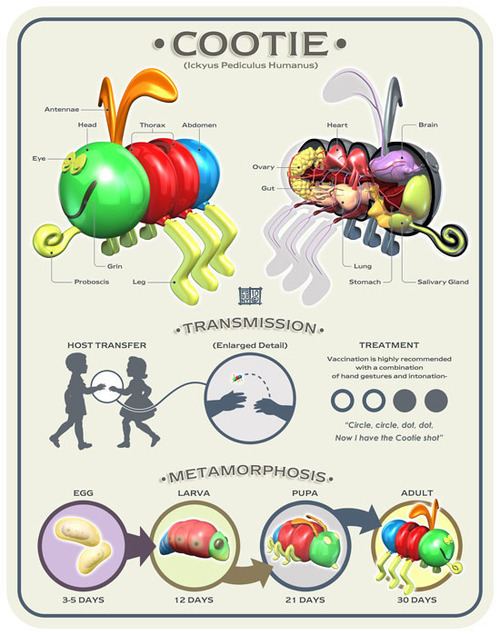 | ||
Cooties is an imaginary childhood disease, used in the United States and Canada as a rejection term and an infection tag game (such as Humans vs. Zombies). It is similar to the British dreaded lurgi, and to terms used in the Nordic countries, in Italy, Australia, England and in New Zealand. A child is said to "catch" cooties through close contact with an "infected" person or from an opposite-sex child of a similar age.
Contents
- Cooties official trailer 1 2015 elijah wood rainn wilson movie hd
- Origin
- Other terms
- Cooties game
- References
Cooties official trailer 1 2015 elijah wood rainn wilson movie hd
Origin
The word is thought to originate from the Austronesian language family, in which the Philippine languages, Maori and Malaysian word kutu refers to a parasitic biting insect. The earliest recorded uses of the term in English are by British soldiers during the First World War to refer to lice that proliferated in battlefield trenches.
A hand-held game, the Cootie Game, was made by the Irvin-Smith Company of Chicago in 1915; it involved tilting capsules (the cooties) into a trap over a background illustration depicting a battlefield. Other cootie games followed, all involving some form of bug or cootie, until The Game of Cootie was launched in 1948 by Schaper Toys. This game was very successful, becoming an icon; in 2003, the Toy Industry Association included it on its "Century of Toys List" of the 100 most memorable and most creative toys of the 20th century.
In addition to the cooties games, the term cooties was popularised in America in the 1950s by military personnel coming back from service alongside the British in the South Pacific. Like the British dreaded lurgi, the cooties games developed during the early 1950s polio epidemic, and became associated with dirt and contagion.
Other terms
The lice of the First World War trenches nicknamed "cooties" were also known as "arithmetic bugs" because "they added to our troubles, subtracted from our pleasures, divided our attention, and multiplied like hell."
In Italy children have the term, la peste ("the plague"). Cooties are known in Denmark as pigelus and drengelus and in Norway as jentelus and guttelus: each pair meaning literally "girl lice" and "boy lice". In Sweden and Finland, it usually refers to girls, where they are known as tjejbaciller (literally "girl bacilli") and tyttöbakteeri ("girl bacteria"). In Serbia the game is known as "šuga"; the word means scabies.
Cooties game
A child is said to "catch" cooties through any form of bodily contact, proximity, or touching of an "infected" person or from a person of the opposite sex of the same age. Often the "infected" person is someone who is perceived as "different", due to disability, shyness, being of the opposite sex, or having peculiar mannerisms. The phrase is most commonly used by children in elementary school aged 4-10; however, it may be used by older children in a sarcastic or playful way. Sometimes the phrase specifies the type of cooties, as in "you've got girl cooties!" or "you've got boy cooties!" after a child has been touched by or in other ways interacted with a child of the opposite sex.
In the United States, children sometimes "immunize" one another from cooties by administering a "cootie injection". Typically, one child administers the "shot", using an index finger to trace circles and dots on another child's forearm while reciting the rhyme, "Circle, circle, Dot, dot, – Now you've got the cootie shot!" In some variations, a child then says, "Circle, circle, Square, square, – Now you have it everywhere!" In this case, the child receives an immunization throughout his or her body. These variations may continue to a final shot where the child says, "Circle, circle, Knife, knife, – Now you've got it all your life!". A number of other variations exist.
